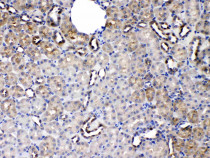ARG59018
anti-PAI3 / SERPINA5 antibody
anti-PAI3 / SERPINA5 antibody for IHC-Formalin-fixed paraffin-embedded sections,Western blot and Human,Mouse,Rat
Overview
| Product Description | Rabbit Polyclonal antibody recognizes PAI3 / SERPINA5 |
|---|---|
| Tested Reactivity | Hu, Ms, Rat |
| Tested Application | IHC-P, WB |
| Host | Rabbit |
| Clonality | Polyclonal |
| Isotype | IgG |
| Target Name | PAI3 / SERPINA5 |
| Antigen Species | Human |
| Immunogen | Recombinant protein corresponding to S86-P406 of Human PAI3 / SERPINA5. |
| Conjugation | Un-conjugated |
| Alternate Names | Protein C inhibitor; PLANH3; Acrosomal serine protease inhibitor; PCI-B; Plasma serine protease inhibitor; Serpin A5; PCI; PROCI; PAI3; Plasminogen activator inhibitor 3; PAI-3 |
Application Instructions
| Application Suggestion |
|
||||||
|---|---|---|---|---|---|---|---|
| Application Note | IHC-P: Antigen Retrieval: By heat mediation. * The dilutions indicate recommended starting dilutions and the optimal dilutions or concentrations should be determined by the scientist. |
Properties
| Form | Liquid |
|---|---|
| Purification | Affinity purification with immunogen. |
| Buffer | 0.2% Na2HPO4, 0.9% NaCl, 0.05% Sodium azide and 5% BSA. |
| Preservative | 0.05% Sodium azide |
| Stabilizer | 5% BSA |
| Concentration | 0.5 mg/ml |
| Storage Instruction | For continuous use, store undiluted antibody at 2-8°C for up to a week. For long-term storage, aliquot and store at -20°C or below. Storage in frost free freezers is not recommended. Avoid repeated freeze/thaw cycles. Suggest spin the vial prior to opening. The antibody solution should be gently mixed before use. |
| Note | For laboratory research only, not for drug, diagnostic or other use. |
Bioinformation
| Database Links | |
|---|---|
| Gene Symbol | SERPINA5 |
| Gene Full Name | serpin peptidase inhibitor, clade A (alpha-1 antiproteinase, antitrypsin), member 5 |
| Background | The protein encoded by this gene is a member of the serpin family of proteins, a group of proteins that inhibit serine proteases. This gene is one in a cluster of serpin genes located on the q arm of chromosome 14. This family member is a glycoprotein that can inhibit several serine proteases, including protein C and various plasminogen activators and kallikreins, and it thus plays diverse roles in hemostasis and thrombosis in multiple organs. [provided by RefSeq, Aug 2012] |
| Function | Heparin-dependent serine protease inhibitor acting in body fluids and secretions. Inactivates serine proteases by binding irreversibly to their serine activation site. Involved in the regulation of intravascular and extravascular proteolytic activities. Plays hemostatic roles in the blood plasma. Acts as a procoagulant and proinflammatory factor by inhibiting the anticoagulant activated protein C factor as well as the generation of activated protein C factor by the thrombin/thrombomodulin complex. Acts as an anticoagulant factor by inhibiting blood coagulation factors like prothrombin, factor XI, factor Xa, plasma kallikrein and fibrinolytic enzymes such as tissue- and urinary-type plasminogen activators. In seminal plasma, inactivates several serine proteases implicated in the reproductive system. Inhibits the serpin acrosin; indirectly protects component of the male genital tract from being degraded by excessive released acrosin. Inhibits tissue-and urinary-type plasminogen activator, prostate-specific antigen and kallikrein activities; has a control on the sperm motility and fertilization. Inhibits the activated protein C-catalyzed degradation of SEMG1 and SEMG2; regulates the degradation of semenogelin during the process of transfer of spermatozoa from the male reproductive tract into the female tract. In urine, inhibits urinary-type plasminogen activator and kallikrein activities. Inactivates membrane-anchored serine proteases activities such as MPRSS7 and TMPRSS11E. Inhibits urinary-type plasminogen activator-dependent tumor cell invasion and metastasis. May also play a non-inhibitory role in seminal plasma and urine as a hydrophobic hormone carrier by its binding to retinoic acid. [UniProt] |
| Cellular Localization | Secreted, extracellular space. Localized on the plasma membrane overlying the acrosomal head of spermatozoa of ependymal spermatozoa and ejaculated sperm. Localized at the equatorial segment of acrosome-reacted spematozoa. Localized in alpha granules in resting platelets and on the external plasma membrane and within the surface-connected cannalicular system in activated platelets. [UniProt] |
| Calculated MW | 46 kDa |
| PTM | N- and O-glycosylated. N-glycosylation consists of a mixture of sialylated bi- (including sialyl-Lewis X epitopes), tri- and tetra-antennary complex-type chains; affects the maximal heparin- and thrombomodulin-enhanced rates of thrombin inhibition. O-glycosylated with core 1 or possibly core 8 glycans. Further modified with 2 sialic acid residues. Proteolytically cleaved. Inhibition of proteases is accompanied by formation of a stable enzyme-inhibitor complex and by degradation of the serpin to lower molecular weight derivatives. Proteolytically cleaved at the N-terminus; inhibits slightly the heparin- and thrombomodulin-enhanced rates of thrombin inhibition. [UniProt] |
Images (3) Click the Picture to Zoom In
-
ARG59018 anti-PAI3 / SERPINA5 antibody IHC-P image
Immunohistochemistry: Paraffin-embedded Mouse kidney tissue stained with ARG59018 anti-PAI3 / SERPINA5 antibody at 1 µg/ml dilution.
-
ARG59018 anti-PAI3 / SERPINA5 antibody WB image
Western blot: Rat liver and SKOV3 lysates stained with ARG59018 anti-PAI3 / SERPINA5 antibody at 0.5 µg/ml dilution.
-
ARG59018 anti-PAI3 / SERPINA5 antibody IHC-P image
Immunohistochemistry: Paraffin-embedded Rat kidney tissue stained with ARG59018 anti-PAI3 / SERPINA5 antibody at 1 µg/ml dilution.








